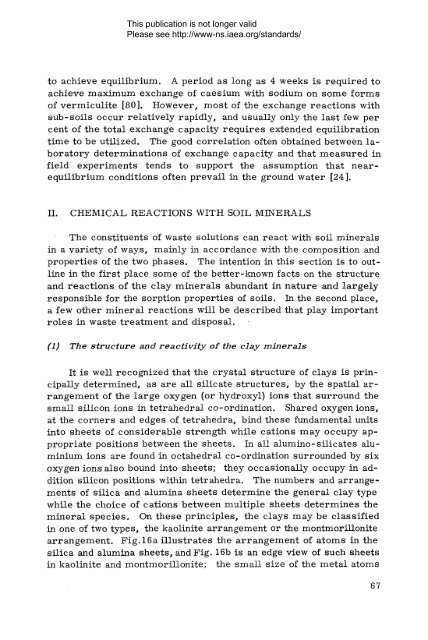Safety_Series_015_1965 - gnssn - International Atomic Energy ...
Safety_Series_015_1965 - gnssn - International Atomic Energy ...
Safety_Series_015_1965 - gnssn - International Atomic Energy ...
You also want an ePaper? Increase the reach of your titles
YUMPU automatically turns print PDFs into web optimized ePapers that Google loves.
This publication is not longer validPlease see http://www-ns.iaea.org/standards/to achieve equilibrium. A period as long as 4 weeks is required toachieve maximum exchange of caesium with sodium on some formsof vermiculite [80]. However, most of the exchange reactions withsub-soils occur relatively rapidly, and usually only the last few percent of the total exchange capacity requires extended equilibrationtime to be utilized. The good correlation often obtained between laboratorydeterminations of exchange capacity and that measured infield experiments tends to support the assumption that nearequilibriumconditions often prevail in the ground water [24],II.CHEMICAL REACTIONS WITH SOIL MINERALSThe constituents of waste solutions can react with soil mineralsin a variety of ways, mainly in accordance with the composition andproperties of the two phases. The intention in this section is to outlinein the first place some of the better-known facts on the structureand reactions of the clay minerals abundant in nature and largelyresponsible for the sorption properties of soils. In the second place,a few other mineral reactions will be described that play importantroles in waste treatment and disposal.(1) The structure and reactivity of the clay mineralsIt is well recognized that the crystal structure of clays is principallydetermined, as are all silicate structures, by the spatial arrangementof the large oxygen (or hydroxyl) ions that surround thesmall silicon ions in tetrahedral co-ordination. Shared oxygen ions,at the corners and edges of tetrahedra, bind these fundamental unitsinto sheets of considerable strength while cations may occupy appropriatepositions between the sheets. In all alumino-silicates aluminiumions are found in octahedral co-ordination surrounded by sixoxygen ions also bound into sheets; they occasionally occupy in additionsilicon positions within tetrahedra. The numbers and arrangementsof silica and alumina sheets determine the general clay typewhile the choice of cations between multiple sheets determines themineral species. On these principles, the clays may be classifiedin one of two types, the kaolinite arrangement or the montmorillonitearrangement. Fig. 16a illustrates the arrangement of atoms in thesilica and alumina sheets, and Fig. 16b is an edge view of such sheetsin kaolinite and montmorillonite; the small size of the metal atoms67
















